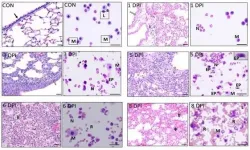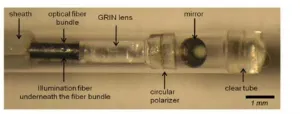Keeping it cool: New approach to thermal protection in outdoor wearable electronics
Scientists develop a radiative cooler that keeps wearable devices cool even under direct sunlight
2021-03-16
(Press-News.org) Wearable electronic devices like fitness trackers and biosensors, are very promising for healthcare applications and research. They can be used to measure relevant biosignals in real-time and send gathered data wirelessly, opening up new ways to study how our bodies react to different types of activities and exercise. However, most body-worn devices face a common enemy: heat.
Heat can accumulate in wearable devices owing to various reasons. Operation in close contact with the user's skin is one of them; this heat is said to come from internal sources. Conversely, when a device is worn outdoors, sunlight acts as a massive external source of heat. These sources combined can easily raise the temperature of wearable devices to levels that not only are uncomfortable for the user, but also cause erroneous readings and measurements. Unfortunately, researchers have been unable to completely address this issue. Most available heat sinks and dissipators for wearable devices are based on thin metallic layers, which block electromagnetic signals and thus hinder wireless communications.
In a recent study published in Advanced Science, scientists from Korea and the US have developed an innovative solution to combat heat in wearable biosensors. Led by Professor Young Min Song from Gwangju Institute of Science and Technology (GIST), Korea, the team produced a nano-/micro-voids polymer (NMVP), a flexible and nonmetallic cooler made from two perforated polymers: polymethylmetacrylate and styrene-ethylene-butylene-styrene.
The resulting material has many attractive qualities. First, it has almost 100% reflectivity in the solar spectrum, meaning that it reflects nearly all sunlight. Second, it has high emissivity in the range of frequencies known as the atmospheric window. Thus, the material can easily radiate excess heat into the atmosphere, which helps cool it down. Finally, the good mechanical properties of the new polymer make it suitable for outdoor wearable devices.
To test the effectiveness of their innovation, the scientists built a patch-type tissue oximeter equipped with an NMVP-based cooler. Thanks to the superior performance of the cooler, their wearable biosensor could externally measure the concentration of oxygen in blood more accurately than conventional oximeters while also maintaining a much lower temperature. "Our approach is the first demonstration of successful thermal management in wearable devices considering both internal and external heat sources without blocking wireless communications," remarks Prof. Song.
The promising results of this study could pave the way for the widespread adoption of wearable devices and biosensors, which will become powerful tools in health monitoring and the training of athletes. With eyes set on the future, Prof. Song comments: "Our flexible strategy for radiative cooling will help bring about thermally protected skin-like electronics, which in turn will make human body monitoring unobtrusive and imperceptible."
The term "cool gadgets" is likely to get a whole new meaning in the future!
INFORMATION:
About Gwangju Institute of Science and Technology (GIST)
Gwangju Institute of Science and Technology (GIST) is a research-oriented university situated in Gwangju, South Korea. One of the most prestigious schools in South Korea, it was founded in 1993. The university aims to create a strong research environment to spur advancements in science and technology and to promote collaboration between foreign and domestic research programs. With its motto, "A Proud Creator of Future Science and Technology," the university has consistently received one of the highest university rankings in Korea.
Website: http://www.gist.ac.kr/
About the author
Dr. Young Min Song is currently serving as a Professor in the School of Electrical Engineering and Computer Science at GIST. He received a Ph.D. in Information and Communications from GIST in 2011. From 2011 to 2013, he was a postdoctoral research associate in the Department of Materials Science and Engineering at the University of Illinois at Urbana-Champaign (UIUC), USA. His group is developing advanced optoelectronic sensors/systems, multifunctional nanophotonics, flexible devices, optical healthcare systems, and radiative cooling devices/materials. He is a co-founder of FOEL Inc.
https://www.gist-foel.net
[Attachments] See images for this press release:

ELSE PRESS RELEASES FROM THIS DATE:
2021-03-16
The vast majority of people infected with SARS-CoV-2 clear the virus, but those with compromised immunity--such as individuals receiving immune-suppressive drugs for autoimmune diseases--can become chronically infected. As a result, their weakened immune defenses continue to attack the virus without being able to eradicate it fully.
This physiological tug-of-war between human host and pathogen offers a valuable opportunity to understand how SARS-CoV-2 can survive under immune pressure and adapt to it.
Now, a new study led by Harvard Medical School scientists offers a look into this interplay, shedding light on the ways in which ...
2021-03-16
A Florida State University professor's research could help quantum computing fulfill its promise as a powerful computational tool.
William Oates, the Cummins Inc. Professor in Mechanical Engineering and chair of the Department of Mechanical Engineering at the FAMU-FSU College of Engineering, and postdoctoral researcher Guanglei Xu found a way to automatically infer parameters used in an important quantum Boltzmann machine algorithm for machine learning applications.
Their findings were published in Scientific Reports.
The work could help build artificial neural networks ...
2021-03-16
Prof. HUANG Weixin and ZHANG Qun from University of Science and Technology of China (USTC) of the Chinese Academy of Sciences (CAS), together with domestic collaborators, probed into the photocatalytic oxidation of methanol on various anatase TiO2 nanocrystals. The results were published on Angewandte Chemie International Edition.
Semiconductor-based photocatalysis has attracted extensive attention since its discovery, owing to its environmentally friendly production of chemical fuel utilizing solar energy.
A photocatalytic reaction consists of light absorption and charge generation within photocatalysts, ...
2021-03-16
Nanozymes, a group of inorganic catalysis-efficient particles, have been proposed as promising antimicrobials against bacteria. They are efficient in killing bacteria, thanks to their production of reactive oxygen species (ROS).
Despite this advantage, nanozymes are generally toxic to both bacteria and mammalian cells, that is, they are also toxic to our own cells. This is mainly because of the intrinsic inability of ROS to distinguish bacteria from mammalian cells.
In a study published in Nature Communications, the research team led by XIONG Yujie and YANG Lihua from University of Science and Technology (USTC) of the Chinese Academy of Sciences (CAS) proposed a novel method to construct efficient-while-little-toxic nanozymes.
The researchers showed that nanozymes ...
2021-03-16
Females who are fit and healthy tend to burn more fat when they exercise than men, according to new research from a team of sports nutritionists.
The research, comprising two new studies from academics led by the University of Bath's Centre for Nutrition, Exercise & Metabolism, analysed the factors that most influenced individuals' capacity to burn body fat when undertaking endurance sports.
How the body burns fat is important to all of us for good metabolic health, insulin sensitivity and in reducing the risk of developing Type II diabetes. But, for endurance sport ...
2021-03-16
Research led by the Cavendish Laboratory at the University of Cambridge has identified a material that could help tackle speed and energy, the two biggest challenges for computers of the future.
Research in the field of light-based computing - using light instead of electricity for computation to go beyond the limits of today's computers - is moving fast, but barriers remain in developing optical switching, the process by which light would be easily turned 'on' and 'off', reflecting or transmitting light on-demand.
The study, published in Nature Communications, shows that a material known as Ta2NiSe5 could switch between a window and a mirror in a quadrillionth of a second when struck by a short laser pulse, paving the way for the development ...
2021-03-16
The bacterial equivalent of a traffic jam causes multilayered biofilms to form in the presence of antibiotics, shows a study published today in eLife.
The study reveals how the collective behaviour of bacterial colonies may contribute to the emergence of antibiotic resistance. These insights could pave the way to new approaches for treating bacterial infections that help thwart the emergence of resistance.
Bacteria can acquire resistance to antibiotics through genetic mutations. But they can also defend themselves via collective behaviours such as joining together ...
2021-03-16
The inclusion of a special new perovskite layer has enabled scientists to create a "spin-polarized LED" without needing a magnetic field or extremely low temperatures, potentially clearing the path to a raft of novel technologies.
Details of the research conducted at the National Renewable Energy Laboratory (NREL) and the University of Utah appear in the journal Science.
Researchers at NREL and around the world have been investigating the use of perovskite semiconductors for solar cells that have proven to be highly efficient at converting sunlight to electricity. Since a solar cell is one of the most demanding applications of any semiconductor, scientists are discovering other uses exist as well.
"We are exploring the fundamental properties of metal-halide ...
2021-03-16
Philadelphia, March 16, 2021 - A significant proportion of hospitalized patients with influenza develop complications of acute respiratory distress syndrome, driven by virus-induced cytopathic effects as well as exaggerated host immune response. Reporting in The American Journal of Pathology, published by Elsevier, investigators have found that treatment with an immune receptor blocker in combination with an antiviral agent markedly improves survival of mice infected with lethal influenza and reduces lung pathology in swine-influenza-infected piglets. Their research also provides insights into the optimal timing of treatment to prevent acute lung injury.
Previously, the investigators found ...
2021-03-16
WASHINGTON -- Researchers have developed a new intravascular imaging technique that could one day be used to detect coronary plaques that are likely to lead to a heart attack. Heart attacks are often triggered when an unstable plaque ruptures and then blocks a major artery that carries blood and oxygen to the heart.
"If unstable coronary plaques could be detected before they rupture, pharmacological or other treatments could be initiated early to prevent heart attacks and save lives," said research team leader Seemantini Nadkarni from the Wellman Center for Photomedicine at Massachusetts General Hospital. "Our new imaging technique represents a major step toward achieving this."
In The Optical Society (OSA) journal Biomedical ...
LAST 30 PRESS RELEASES:
[Press-News.org] Keeping it cool: New approach to thermal protection in outdoor wearable electronics
Scientists develop a radiative cooler that keeps wearable devices cool even under direct sunlight




